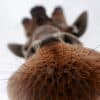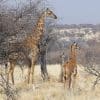World Giraffe Day is an exciting annual event initiated by GCF to celebrate the tallest animal on the longest day (or night) of the year – 21 June – every year! This year, World Giraffe Day 2017 focuses on the Masai giraffe in southern Kenya and Tanzania.
Some giraffe populations have been harder hit than others and Masai giraffe seem to be taking the brunt of it. As one of the most populous giraffe populations in Africa, there are only 32,000 Masai giraffe remaining in southern Kenya and Tanzania. Their number has dropped by more than half in the last 30 years.
And this alarming trend continues.
GCF is raising funding to support a collaborative effort with local and regional partners in East Africa to help the Masai giraffe. GCF is partnering with the Kenya-Tanzania Borderland Conservation Initiative and its partners, as well as the Kenya Wildlife Service, to focus on community-based conservation of Masai giraffe.
Some of the key programmes are:
- Collar Masai giraffe with GPS satellite solar units that allow remote tracking to better understand the space these giraffe use and the range they travel.
- Equip local rangers to monitor survey and support anti-poaching of Masai giraffe.
- Create an Africa-wide giraffe database that will help conservationists, wildlife managers and researchers better understand giraffe distribution and ecology.
You can support these important, innovative and unique giraffe conservation efforts by helping us to raise much-needed funds on World Giraffe Day – 21 June 2017.
Help us reach our funding goal of US$100,000 this year.
World Giraffe Day 2016 put people at the centre of giraffe conservation.
Awareness and funding was raised in support of two important programmes in Kenya and Namibia:
In Kenya, in an immense collaborative effort lead by Kenya Wildlife Service our collaborative team including San Diego Zoo Global, Loisaba Conservancy, Northern Rangeland Trust, Lewa Conservancy, The Nature Conservancy, Smithsonian, Senckenberg Museum and many more, fitted newly designed GPS solar satellite tracking units to eleven reticulated giraffe earlier this month. The support of WGD 2016 made this operation possible. With only about 8,700 reticulated giraffe remaining in the wild, it is critical to work with local partners to protect these magnificent animals. Twiga Walinzi (Giraffe Guards) have worked on the ground for over a year now to learn more about this population and in combination with a better understanding of giraffe movements across the landscape, land managers and communities can soon make more effective and efficient decision to maintain a peaceful co-existence between giraffe, humans and their livestock.
In Namibia, WGD 2016 supported the Khomas Environmental Education Programme (KEEP), which aims to inspire young Namibians to care for their environment through a targeted hands-on field based programme. Last year almost 2,000 primary school students enjoyed a field day with GCF’s education staff. With the support of WGD 2016, this year we have already hosted over 1,250 students, and are set to hit our target of 2,500 inspired young Namibian conservationists for 2017.








Really nice foundation! I have shared this article on my page in fb. Hopefully we can bring more people to saving these beautiful animals
Publishing on Planeta.com http://planeta.com/world-giraffe-day
https://uploads.disquscdn.com/images/49bf90d62318e77cb762e08c5667b8772f8dee89a4e43d5e2700037ce9c6103d.jpg